Our proud heritage
International Museum Day falls today:
By Rosanne Koelmeyer Anderson
[email protected]
|
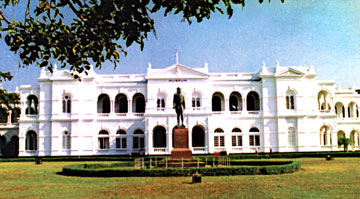
Colombo National Museum
|
Constructed on a beautiful landscape of seven acres in Colombo 7 at
853 Sir Marcus Fernando Mawatha stands a colonial edifice: the National
Museum of Colombo dating back to 1877; the consequence of the then
Governor of Ceylon, Sir Henry William Gregory’s zeal to cosset our
strikingly enchanting island’s antiquity.
Today, as the world celebrates International Museum Day we
reminiscence the grandeur of the largest museum in South Asia; a fine
tourist attraction which would take you back in time giving you a
precise account of a bygone era and the evolution of a nation’s
civilization.
This museum was opened to the public on January 1, 1877 with a
remarkable collection of 800 artifacts. Interestingly, the impressive
construction is said to have apparently cost Rs. 119,993.93: at a time
when European and Asian countries were much focused on building
associations to protect the antiquity of their nations.
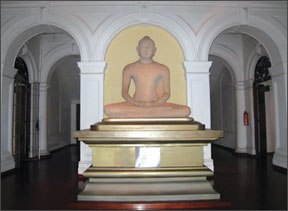
The entrance of the museum

The second floor of the museum |
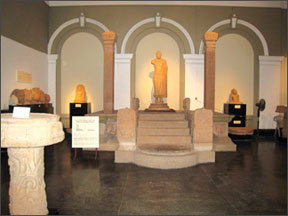
The Anuradhapura period |
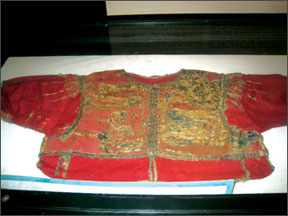 |

Last king of Kandy, Sri Wickrema Rajasinhge and Queen’s jackets |
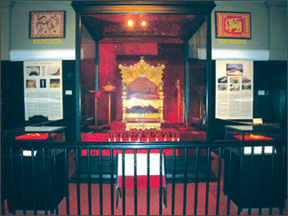
Throne-Kandyan Period |
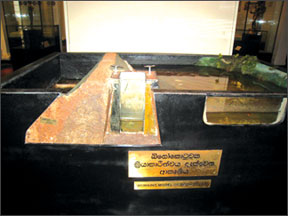 |
It was the British colonial Governor, a cultural and natural heritage
enthusiast who then made known to the State Council members that there
was a necessity for a museum and thus the National Museum of Colombo
came into existence under his supervision in the 19th century.
This white edifice is one of the finest historical monuments in the
city of Colombo.
Prior to housing the invaluable artifacts at the Colombo National
Museum, much research of course had been done by officers of the public
services and a considerable collection of antiques and specimens of
natural sciences were available which the Ceylon branch of the Asiatic
Society had later possessed in 1850. It was only in 1877 with the
opening of the National Museum that all these priceless treasures of
yesteryear were transferred and found its permanent abode.
Today, the National Museum boasts of having more than 2000 antiques
and a very extensive Natural History Museum with over 5000 specimens.
Having begun to grow in popularity, by 1940 the first Sri Lankan
director who understood the importance of a museum, Dr P. E. P.
Deriniyagala paved the way to enriching our national heritage so much so
that he opened branch museums in Jaffna, Kandy and Ratnapura and
established a fully fledged Department National Museums in 1942 and thus
more museums were established around the country.
Dr. Nanda Wickremasinghe, the Director of the National Museum of
Colombo in an interview with the Sunday Observer said HSBC had stepped
in to financially assist the Colombo National Museum gigantic
refurbishment program which should conclude by 2010.
Up to now Rs. 15 million has been spent for refurbishment having
completed the ground floor and part of the upper floor and the
government hopes to complete the refurbishment program with the help of
the Government of Netherlands.
The thematically set out National Museum of Colombo takes you through
from the prehistoric stone antiquities from religious icons,
architectonic and decorative sculptures, historic documents in the form
of stone pillars and slab inscriptions of old Sinhalese, Tamil, Arabic,
Portuguese, Dutch and British household utensils to the Anuradhapura
Period from the 2nd Century relating to agriculture and irrigation
practiced by primitive man.
Trade, coinage, early Buddhism, Hinduism, language and literature,
health and sanitation practices, arts and crafts, paintings and
sculpture, architecture and Buddhist Monastery type artifacts are some
of the historic traces displayed.
Similarly, the Polonnaruwa Period in addition depicts palace
architecture while the Kandyan period portrays the Royal throne and
crown of the last king of Kandy, Sri Wickrema Rajasinhge, the trilingual
inscription, viharas, crafts, brassware and the betel-chewing culture in
addition to the similarities of other periods of Sri Lankan history.
With the view to enhancing the surroundings and improving the
infrastructure of this national treasure, the director said a car park
is being constructed and canteen facilities are also in progress.
Moreover, much more is on the refurbishment agenda: ground plans are
also in progress to set up a Textile Gallery, Sculpture, Painting,
Pottery and Anthropology Galleries too.
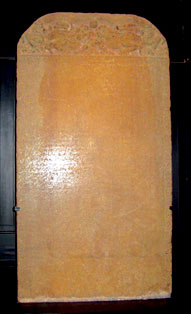
Trilingual inscription |
Together with the on going development, a website for the museum:
www.museum.gov.lk has also been set up in keeping with state-of -the-art
technology. Incidentally, in view of International Museum Day, the
museum will be opened to the public free of charge today, May 18 but on
other days a nominal fee of Rs. 500 for foreigners, Rs. 20 for locals
and Rs. 10 for school children will be charged on all days from 9 a.m.
to 5 p.m. except on Fridays and public holidays.
The services of graduate guides are available if required while on
tour at the museum which would take you approximately 2 hours or more,
the director said.
‘Sri Lanka has nine acclaimed regional museums to its tribute: the
Galle Maritime Museum which was affected by the tsunami but is now
almost completing reconstruction, the Anuradhapura Folk Museum which
depicts Sri Lankan folk life and art which is eagerly awaiting a reply
to a proposal put to the American Embassy for its refurbishment, the
National Museum Ratnapura which has 7 acres of land and a spacious
garden area which will have an opera air museum soon: work on it has
already commenced in a bid to establish prehistoric environment, endemic
plants and fauna and flora as well as the Sabaragamuwa dances and dance
costumes’.
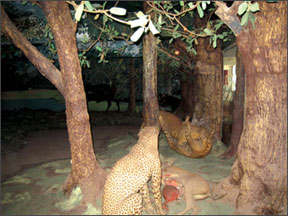
Leopard of Punani |

Aquatic bird gallery |
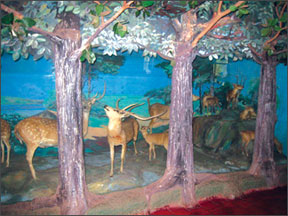
Mammal gallery |
‘The Dutch Museum Pettah which houses Dutch artifacts, although in
the heart of Colombo has however turned out to be rather ineffective as
there is no parking facilities at all and authorities are contemplating
on shifting it to the Dutch Fort, Galle due to the inconvenience’.
The other attraction is the National Museum of Natural History
established in 1986 which is housed at the rear end of the National
Museum of Colombo: yet another splendid piece of art which reflects a
vast array of natural heritage of plant and animal species endemic to
Sri Lanka: specimens of mammals, the leopard of Punani which was shot in
Batticoloa on August 16, 1924 which had killed the largest number of
people, 13 to be precise, the Red faced Malkha birds, reptiles like Naja
naja and Viper russelli, insects, fish, amphibians and indigenous
fossils belonging to Jurassic, and various kinds of geological rocks; a
mesmerizing sight for the visitor.
Also, the Independence Memorial Museum at Independence Hall which was
inaugurated on February 3, 2008, the latest addition has been set up to
depict the story and struggles relating to independence with historic
specifics of 25 national heroes: the cluster is a fine attribution to
every sphere of our historic milieu in its endeavour to preserve our
national heritage.
Moreover, The National Museum Library is also proud to be the pioneer
library in Asia with over 4,000 books to its credit including the most
recent Olla leaf book and the first book printed in Sri Lanka adding
splendour to its distinguished culture merge with its incomparably rich
national heritage: Lassana Sri Lanka is certainly a land of rich
diversity like no other.
Pix by: Rosanne Koelmeyer Anderson |
